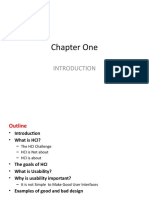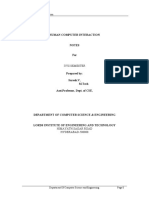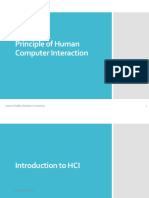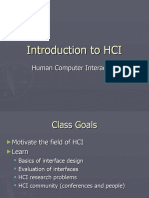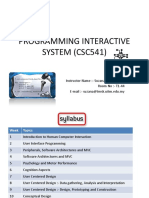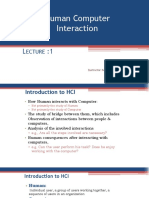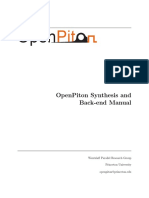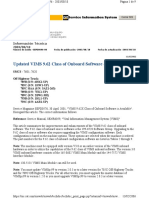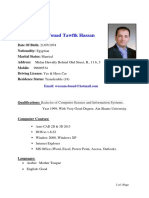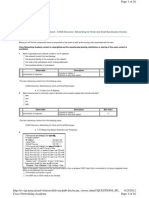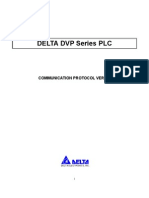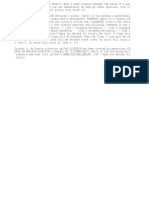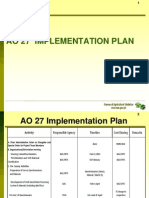WELCOME TO SEMINAR
HUMAN COMPUTER INTERFACE
UNDER THE GUIDENCE OF :
MISS. JAYA PANIGRAHY (LECTURER OF CSA DEPT.)
SUBMITTED BY :
NAME:: SANJAYA KUMAR JENA REGD. NO:: 0805106018 BRANCH:: MCA (4th SEM.)
�CONTENTS
Introduction Goals of HCI Usability in design Components of usability Design of HCI Types of user interfaces Benefits of common interface Excellence of HCI Conclusion
�INTRODUCTION
Human-Computer Interface The study of the design, evaluation, and implementation of interactive computing systems for human use and the major phenomena surrounding them. HCI often called as sociotechnological discipline. Three parts: the person, the computer, and By which they work together
�MEANING
Human
the end-user the others in the organisation
Computer
hardware software
Interface
user tells the computer what (s)he wants computer communicates results
�Contd
HCI draws the knowledge from computer science ,graphic design, management, psychology and sociology etc.. By using this one can able to learn foreign language, analyzing aerodynamics of new aero plane, planning surgery, playing computer game, accessing information on world wide web.
�GOALS OF HCI
Design and develop systems that are usable, efficient, and safe. Design and develop systems that are intuitive.
Allow people to use them with a minimum of change and disruption.
Make data exchange between people and machines less stressful and less chance of Misunderstandings.
�USABILITY IN DESIGN
Usability is one of many factors that software designers must take into account when designing a New user interface. Usability sometimes neglected leads to greater cost A skilled interface designer cant miss the important information.
�COMPONENTS OF USABILITY
Usability has 5 quality components 1. 2. 3. 4. 5. Ease of learning Efficiency of use Memorability Error frequency Subjective satisfaction
�DESIGN OF HCI
There are 3 models. 1. Waterfall model. 2. Rapid prototyping. 3. The star life cycle model.
�THE WATERFALL MODEL
Feasibility study Requirements analysis & specification System & software design Implementation& unit testing Integration & system testing
Maintenance
�FEASIBILITY STUDY
only important requirement of customers are captured. Identify all the ways of solving the problem. Analyze merit and demerit and the best solution is identified
�REQUIREMENTS ANALYSIS AND SPECIFICATION
1.Requirement gathering and analysis. 2.Requirement specification(preparation of SRS document).
�DESIGN
1.Traditional design approach. 2.Object oriented design approach.
CODING & UNIT TESTING
1 coding 2 unit testing
�INTEGRATION AND SYSTEM TESTING
1.Integration. 2.System testing Testing Testing Acceptance testing
�MAINTENANCE 1.Corrective maintenance. 2.Perfective maintenance. 3.Adaptive maintenance.
�THE STAR LIFE CYCLE
Task analysis / functional analysis
Implementation
Evaluation Prototyping Requirements specification
Conceptual design / formal design
�PROTOTYPING
Requirements gathering
Quick design
Refine requirements incorporating customer suggestions
Build prototype
Customer evaluation of prototype
�USER INTERFACES 4 TYPES
1. Command Line Interface (CLI)
2. Menu Driven Interface 3. Graphical User Interface (GUI) 4. Natural Language Interface
�BENEFITS OF A COMMON INTERFACE
There are five advantages to the common user interface:
1 Increased speed of learning
2 Ease of use 5 Greater range of software available to the average computer user
3 Confidence for novice users 4 Increase the range of solvable tasks by users
�EXCELLENCE OF HCI
Quality of life. National competitiveness. Growth of computer and communication industries. National security.
�CONCLUSION
As computers are found every where and play an increasing role in our lives, the importance of human computer interface is highlighted. All software written today employs user interface toolkit and interface builder concept. Even www is a direct result of HCI research. Applying Hypertext technology to browsers allowing one to traverse a link across the world with a click of mouse.
�THANK YOU



















